I was walking with a friend through his fruit tree orchard a couple weeks ago when he knelt down to pull up a weed.
“Oh, I love that plant,” I said.
“These things are everywhere. What is it?”
“It’s called deerweed. It’s a native plant. It has little yellow and orange flowers all over. It’s really pretty and the bees and butterflies like it.”
In my yard, I cultivate deerweed. I protect it, I encourage it.
See that photo at the top? That’s an unattractive deerweed in the foreground. Looks like a dead bush, I know, but come spring it will be beautiful.
Here’s a photo of some new leaf growth on another deerweed in my yard:
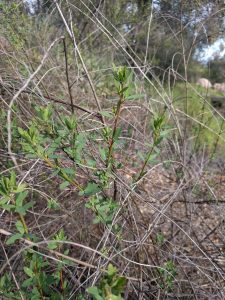
When I moved into my house six years ago, half the yard was native plants with weeds and the other half was pure weeds. Some weeds I knew, like tumbleweed. I quickly set to eradicating that. But others I couldn’t identify. One such plant I came to know was deerweed, and once I learned its name I was able to learn all kinds of things about it.
Deerweed’s botanical name is Acmispon glaber or Lotus scoparius, and one of its interesting characteristics is that it’s a nitrogen fixer. What’s that? Some plants have the ability to take the nitrogen that is floating around in the air and change its chemical composition (“fix” the nitrogen) so that the plant can take it into its roots. In actual fact, the plant doesn’t do this on its own. There are bacteria that live in the soil that do the nitrogen fixing, and they live attached to the plant’s roots. The bacteria fix the nitrogen, feed it to the plant’s roots, and the plant in return feeds carbohydrates back to the bacteria. Fascinating stuff!
Most plants are incapable of having this relationship with nitrogen-fixing types of bacteria, but deerweed is one of the few. (Peas, alder trees, and clover are a few of the others.)
(Read more about deerweed and see better photos here at Las Pilitas.)
What is a weed, precisely?
What is a weed? To most of us, a weed is simply the label we give to a plant that is growing where we don’t want it. The concept is entirely subjective — that is, my friend thought deerweed was a weed, but I didn’t.
Weeds are not equally undesirable. I have a lot of weeds in my yard. Some of them I loathe (ripgut brome), and some of them I mildly dislike (whitestem filaree — bees do love its flowers, and it’s fun to make scissors out of its seedheads, but its corkscrew seeds stick to everything).
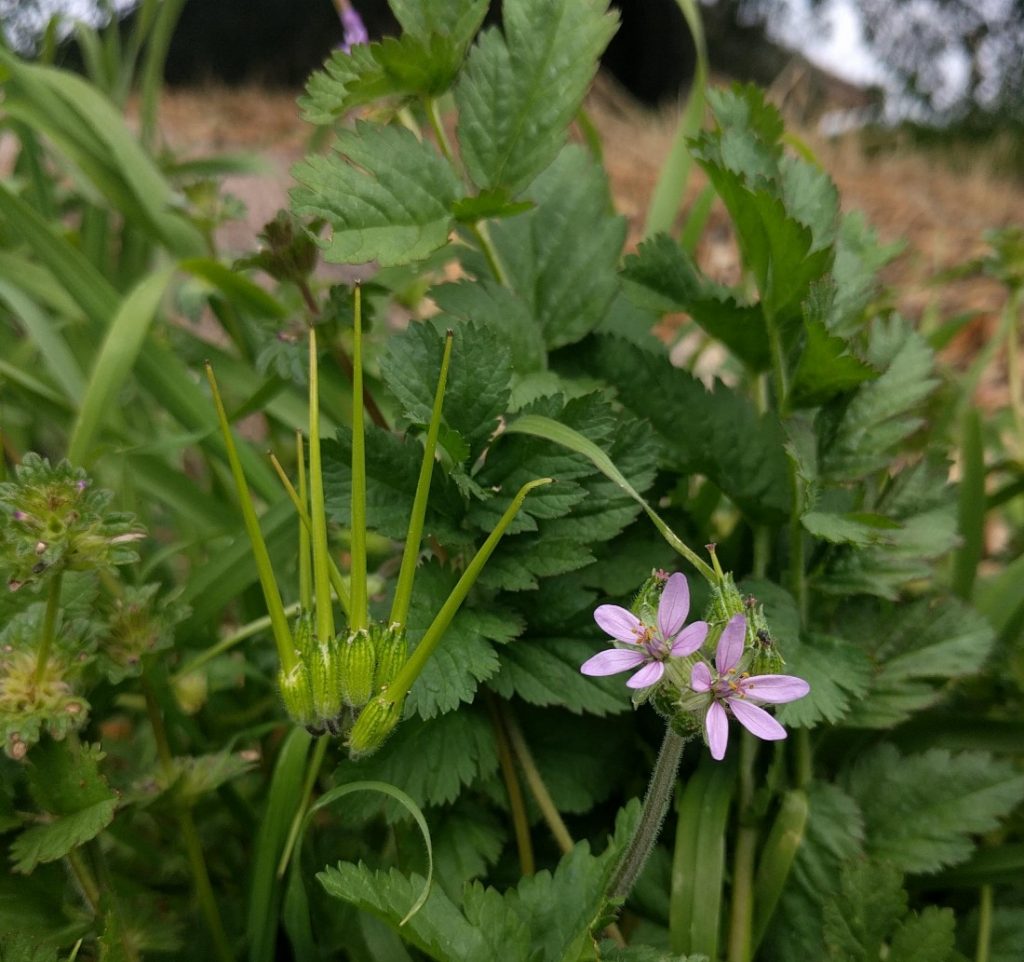
Wherever the native vegetation has been removed, weeds will fill in. Count on it. The earth demands that its soil surface be covered. Weeds provide this covering, and we have the opportunity to encourage or discourage whichever weeds show up.
Sometimes before pulling a weed in the garden, we should take the time to learn its name.
It’s impractical to do this every time, all the time, but over time if you learn the names of the weeds in your yard you then gain access to the information that others have gathered about them for a thousand years, and not only will you learn to manage them better but you will also declassify some as “weeds”.
Weed scientists think of weeds differently. They classify plants as weeds if the plants are very competitive and are hard to control in a landscape. So while my friend thought deerweed was a weed, no weed scientist would define it so because deerweed is neither very competitive nor hard to control. In my own yard, I’ve lost deerweed plants to actual grass weeds because the grass weeds grow very fast and produce prodigious amounts of seed; they overtake the deerweed within a year or two.
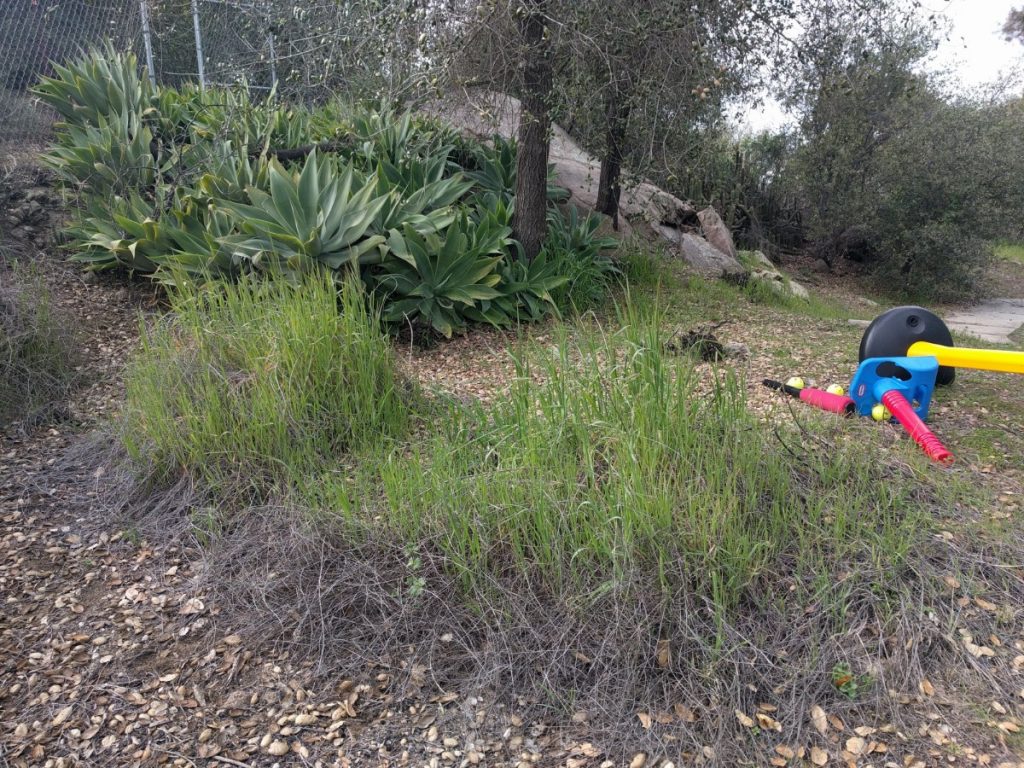
Before killing it, name that weed
I’ve got a new weed in my yard this year. It’s not totally new, but I’m seeing much more of it this year than in years past, and up until the other day I hadn’t learned its name.

How do you learn the name of a weed? One method is to use the University of California’s Weed Gallery. I took the above photo, and then I went to the Weed Gallery website and began searching.
If you use the weed gallery, you should search by using as many identifying characteristics as you can. You might have to follow many trails before finding your plant.
For example, with this plant I first clicked on “Broadleaf identification” because it doesn’t have narrow leaves like grass. Then I clicked on “whorled leaves” but that ended up not showing my plant, so I backed up and clicked “roundish (orbicular) leaves”, which also ended up not showing my plant. I wondered if my plant wasn’t in the gallery.
I looked at my photo again. Then I backed up and clicked on “lobed edges”. The plant does have lobed edges. Voila! Henbit, or Lamium amplexicaule. I have the name!
Before I went further and learned about how henbit reproduces itself, what its seedlings look like, etc., I already knew I wasn’t going to immediately remove it because while I was taking the photo of this henbit I had noticed something hanging on the lip of one of its flowers. I moved closer to get a better look. I couldn’t believe my eyes. That’s a Ceratina species!
It crawled inside the henbit flower, then it backed out. Yes, that’s a small carpenter bee, a native bee!
I hadn’t seen a single native bee in my yard yet this year, and then to see a small carpenter bee . . . on a weed. Hmmm.
Sure makes me think twice about killing the henbit, at least until the non-weeds are in bloom.
(See some amazing photos of Ceratina bees here at the U.S. Geological Survey’s Native Bee Inventory and Monitoring Program.)
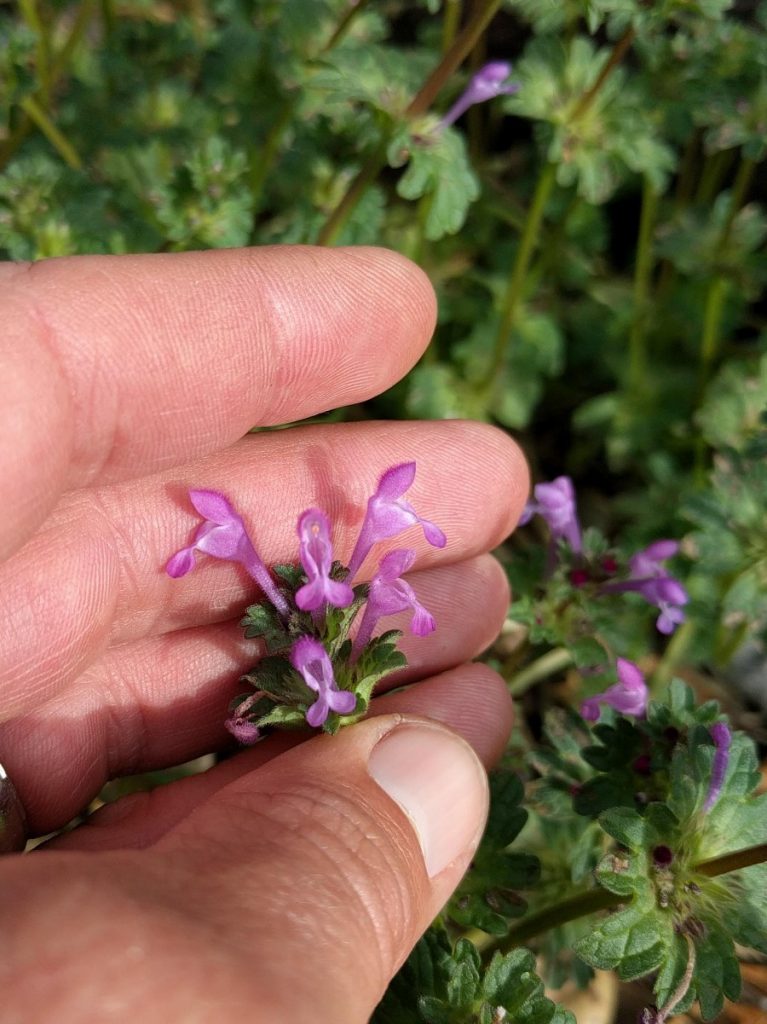
You might also like to read:

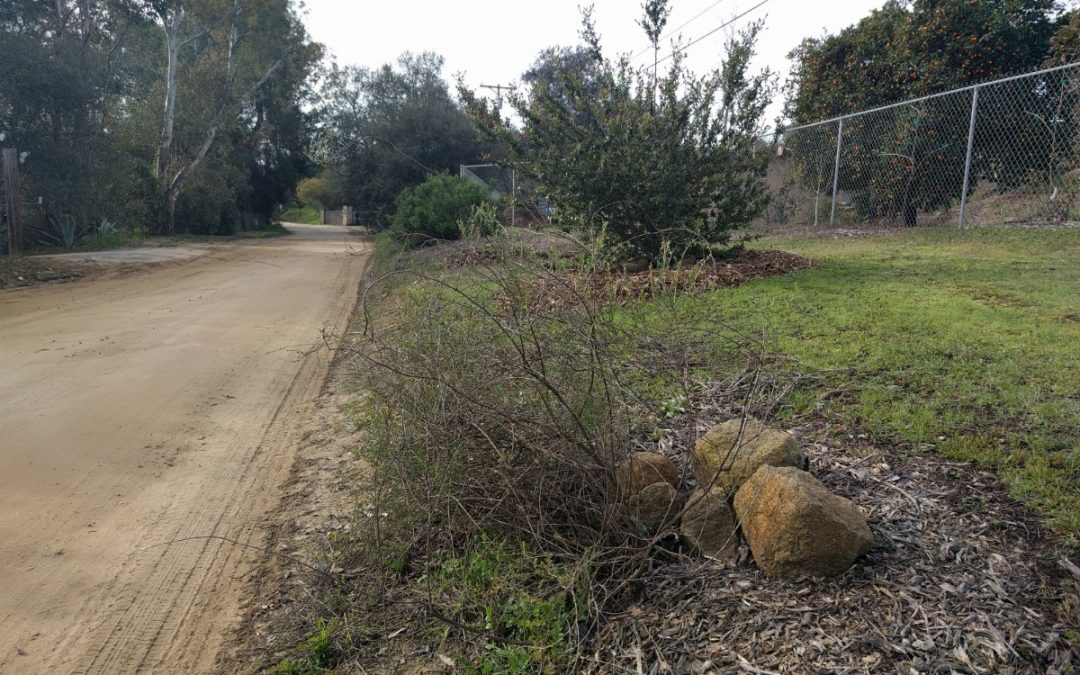


Thank you Greg! I just planted deerweed in my parking strip after learning about it from the beloved Las Pilitas nursery. I am hoping as a ‘pioneeer’ plant it will help make a friendly space for an oak and native buckwheat very soon.
Hi Amy,
I would guess that your plan will work out: in the natural areas of my yard, deerweed grows alongside both buckwheat and oaks. I hope it happens for you too.
I recently downloaded an app called Plant ID to my iphone that has helped me tremendously in trying to figure out what’s growing in the yard. It isn’t always 100% correct but it gives me a jumping off point, at least. I was just on-line this morning looking for the type of ID tool you described. Can’t wait to play around with the one you linked!
Greg, I am really enjoying your blog. I get the newsletter and love the updates. I’ve learned a lot and this is a great resource for me.
This post hits me hard in two specific ways. First, my husband taught me the line, “a weed is any plant growing where you don’t want it,” early in our relationship. Here I am, married to that guy 18 years later. Next, I, too, just discovered Lamium amplexicaule! I saw it for the first time* on Monday 2/25/19 and went back to it the next day to swipe a stalk for future identification. The flowers are incredibly cute; tiny yet with loads of details, the flower buds are like tiny purple polka-dots. I’m already dreaming of seed planting throughout my yard. Like you, I’ve never noticed it before, and I’m excited it’s a native and that carpenter bees love it! I love my pollinators.
* I saw the Lamium while walking near the cancer center in Santa Barbara, where my husband is now being treated.
We never knew the name of whitestem filaree and have been calling it the “Edward Scissorhands” weed for years. Thankfully easier to pull now that the ground is wet. Some very wet years they grew to between knee and thigh high.
We too have henbit coming up for the first time- thank you for also identifying that.
We also didn’t know the name of the dreaded ripgut brome. Ours are going to seed and recommend diligence in pulling these out before they go to seed as they take over. I have also heard them referred to as foxtails. Our dog got one in her throat and it was a $550 veterinarian bill.
The Luminae is not a weed as far as my purchase 5 years ago, where I paid for “wildflowers” for bee friendliness.
You have it naturally, that’s lovely. Because of this article I’m going to keep them whereas my husband thinks of them as weeds.
I get yellow budded clover naturally, and I heard that weeds and wf can speak to you. This speaks of good drainage areas in the garden.
I have a steep embankment. I used to pull weeds, but now I usually leave the roots to help keep the soil in place. The weeds grow back, but anything to help against erosion. So, there is another purpose for weeds. When I bought my home, the back was loaded with red apple. I finally got rid of most of it. When it would bloom it would attract all the bees and my avocado flowers were not getting fertilized. The ivy is a pain, but I have to maintain it on the embankment for stability. Any suggestions for plants to replace ivy?
Hi Richard,
I totally agree about using weeds for erosion control. This is one of the reasons that I have so many weeds in my yard: it’s superior to bare dirt in that respect.
There are so many ways you can go with plants to replace ivy, depending on whether you want the new plant to also be low growing, or unirrigated, or edible, or native, etc. I’ve seen some nice freeway embankments covered primarily with buckwheat and coast sunflower (Encelia californica). That would be good for the bees and other insects, attractive, plus low maintenance and unirrigated eventually.
Your posts are so helpful. I will keep an eye out for deerweed. Any nitrogen fixer is great in my book.
They say the difference between a flower and a weed is an opinion and it’s so true. I’ve stopped pulling out the dandelion plants on my slope and started harvesting the greens instead. I was pleasantly surprised to find they are mild and super healthy, plus the plants help with soil erosion and the bees love them. Win, win, win.
HI Greg..since you are on a topic of weed, in my yard right now certain area are just sprouting with clover. I’m planning to pluck them out. Can these be used as mulch for my fruit trees?
-James
Hi James,
Probably. But I would make sure there aren’t viable seeds on the plants. There are different kinds of clover, and if you have burclover then you might not want that proliferating. Here is a page that might help you identify your clover.
Another method to identify weeds – or really anything – is with an app called Google Lens. I used it when we were in Puerto Rico to identify all sorts of plants.
It uses your camera to take an image of the plant (or whatever) and then searches for similar images on google. It has worked for me more often than not.
What do you think about planting a clover lawn as an alternative to grass? It seems like the ultimate friendly “weed.”
Hi Mimi,
I agree. The only downsides I can think of are that some clovers have flowers that bees love (don’t want to play soccer on a lawn full of honey bees), and burclover would hurt to walk on barefoot: so just choose the right type of clover, or clovers.
Greg,
Another question on weed control. When I planted my avocado, I mixed with soil that has nutsedge seeds. Now the soil around my avocado tree from the trunk to beyond the drip line has a nutsedge problem. I have removed them by hand as much as I can. I used a hand trowel trying to get the nuts below the ground. But every couple days or so, 5 or 6 nutsedges would pop up from the layer of mulch and I remove them again. I don’t want to use a hand trowel to dig and disturb the root too much. Do you think a weed barrier made of Polypropylene would be able to control nutsedge? I saw these weed barrier for sale on Gemplers.com.
Hi James,
Nutsedge is a pain. I had it in my old garden. I do think a weed barrier would work, but you’d have to make sure the avocado is still watered properly. When I’ve seen others use weed fabric under avocados, it was difficult for them to water well because they couldn’t check the soil moisture easily.
An alternative is that you just keep pulling the nutsedge sprouts as soon as you see them. Eventually, you can control them this way, but it takes at least a couple years.
Hi Greg! Thank you for reposting older posts like this. You provide such valuable and interesting information to your readers, and I cannot thank you enough!
Hi Greg :
The App -“Picture this ” is great for identifaction of plants
If you see a plant you don’t recognise -open the app -take a pcture and it will tell you everything about it